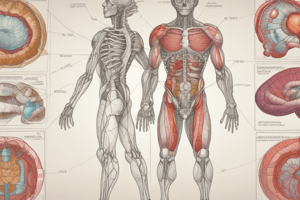Podcast
Questions and Answers
Which type of tissue is responsible for movement, contraction, and relaxation?
Which type of tissue is responsible for movement, contraction, and relaxation?
- Connective tissue
- Muscle tissue (correct)
- Epithelial tissue
- Nervous tissue
What is the primary function of sodium channels during an action potential?
What is the primary function of sodium channels during an action potential?
- Resting potential maintenance
- Rapid depolarization (correct)
- Neurotransmitter release
- Rapid repolarization
What is the phase of the action potential where the membrane potential returns to its resting state?
What is the phase of the action potential where the membrane potential returns to its resting state?
- Action potential
- Depolarization
- Repolarization (correct)
- Refractory period
Which type of action potential occurs in smooth muscle cells and autonomic neurons?
Which type of action potential occurs in smooth muscle cells and autonomic neurons?
What is the resting potential of a neuron, approximately?
What is the resting potential of a neuron, approximately?
What type of tissue provides support, structure, and connectivity to the body?
What type of tissue provides support, structure, and connectivity to the body?
Flashcards are hidden until you start studying
Study Notes
Histology
Tissue Types
- Epithelial tissue: forms the lining of organs, glands, and body surfaces; functions in absorption, secretion, and protection
- Connective tissue: provides support, structure, and connectivity to the body; includes bone, cartilage, fat, and blood
- Muscle tissue: responsible for movement, contraction, and relaxation
- Nervous tissue: specialized for transmitting and processing information
Action Potential
Definition
- A rapid, temporary change in the electrical potential of a neuron or muscle cell
- Generated by a rapid influx of sodium ions and a rapid efflux of potassium ions
Phases
- Resting phase: the neuron is at rest, with a negative resting potential (approximately -70mV)
- Depolarization: the membrane potential becomes less negative, reaching a threshold (approximately -55mV)
- Action potential: the membrane potential rapidly becomes positive (approximately +30mV)
- Repolarization: the membrane potential returns to its resting state
- Refractory period: the neuron is unable to generate another action potential
Ion Channels
- Sodium channels: responsible for rapid depolarization
- Potassium channels: responsible for rapid repolarization
- Calcium channels: involved in neurotransmitter release
Types of Action Potentials
- Somatic action potentials: occur in skeletal muscle cells
- Autonomic action potentials: occur in smooth muscle cells and autonomic neurons
- Cerebellar action potentials: occur in cerebellar Purkinje cells
Histology
Tissue Types
- Epithelial tissue forms the lining of organs, glands, and body surfaces, functioning in absorption, secretion, and protection.
- Connective tissue provides support, structure, and connectivity to the body, including bone, cartilage, fat, and blood.
- Muscle tissue is responsible for movement, contraction, and relaxation.
- Nervous tissue is specialized for transmitting and processing information.
Action Potential
Definition
- A rapid, temporary change in the electrical potential of a neuron or muscle cell occurs due to rapid influx of sodium ions and rapid efflux of potassium ions.
Phases
- Resting phase: neuron at rest with negative resting potential (approx. -70mV).
- Depolarization: membrane potential becomes less negative, reaching a threshold (approx. -55mV).
- Action potential: membrane potential rapidly becomes positive (approx. +30mV).
- Repolarization: membrane potential returns to resting state.
- Refractory period: neuron unable to generate another action potential.
Ion Channels
- Sodium channels are responsible for rapid depolarization.
- Potassium channels are responsible for rapid repolarization.
- Calcium channels are involved in neurotransmitter release.
Types of Action Potentials
- Somatic action potentials occur in skeletal muscle cells.
- Autonomic action potentials occur in smooth muscle cells and autonomic neurons.
- Cerebellar action potentials occur in cerebellar Purkinje cells.
Studying That Suits You
Use AI to generate personalized quizzes and flashcards to suit your learning preferences.




